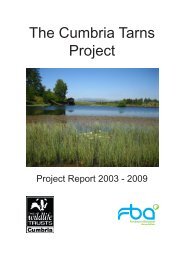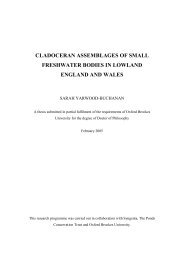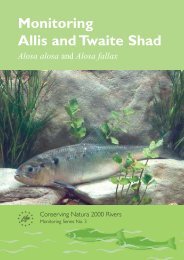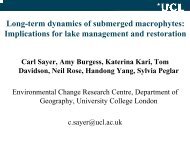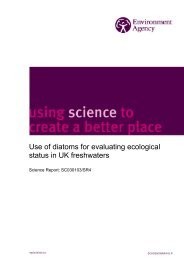Groundwater HIA post edit - FreshwaterLife
Groundwater HIA post edit - FreshwaterLife
Groundwater HIA post edit - FreshwaterLife
You also want an ePaper? Increase the reach of your titles
YUMPU automatically turns print PDFs into web optimized ePapers that Google loves.
Principle 1: The impact of a groundwater abstraction spreads until it has stopped<br />
an equal amount of water leaving the aquifer. Imagine an aquifer system that is in<br />
long-term equilibrium and where there are no abstractions. Inputs to the system may<br />
include recharge from rainfall, regional groundwater flow, and infiltration from surface<br />
water. Discharges from the aquifer may include springs, seepages, baseflow to rivers,<br />
and regional groundwater flow. A simplified system of an island in a fresh water lake,<br />
receiving rainfall recharge, is illustrated in Figure 2.3 (upper diagram). Now imagine<br />
that a borehole is drilled, abstraction commences, and a cone of depression starts<br />
spreading out from the borehole. Initially, the abstraction takes water from storage,<br />
and the flow of groundwater into the lake is unaffected (Figure 2.3, middle diagram).<br />
However, as the cone of depression spreads, it eventually reduces the gradient of the<br />
water table where it intersects the lake, and groundwater flow into the lake will be<br />
reduced (Figure 2.3, lower diagram).<br />
Figure 2.3 Impact of groundwater abstraction on aquifer discharges<br />
(after Bredehoeft et al 1982; note that the rainfall continues in the middle and lower diagrams)<br />
The first principle to emphasise therefore, is that the effect of the abstraction will<br />
spread until it has stopped an equal amount of water from leaving the aquifer (in both<br />
confined and unconfined aquifers). This will usually be in the form of reduced<br />
discharges (reduced springflow, reduced baseflow, or reduced seepage, for example).<br />
In other words, all groundwater abstractions eventually have an impact, it is only a<br />
question of where the impact will appear and how long it will take. This subject was<br />
addressed over 65 years ago by Theis (1940), who said:<br />
“Under natural conditions…previous to development by wells, aquifers are<br />
in a state of approximate dynamic equilibrium. Discharge by wells is thus a<br />
new discharge superimposed upon a previously stable system, and it must<br />
be balanced by an increase in the recharge of the aquifer, or by a decrease<br />
in the old natural discharge, or by loss of storage in the aquifer, or by a<br />
combination of these.”<br />
Principle 2: Impacts can be changes in flow as well as water level. It will be seen<br />
later that the procedure for <strong>HIA</strong> differentiates between impacts due to changes in flow<br />
and impacts due to changes in groundwater level. Impacts from changes in level are<br />
easy to visualise, and include for example, lower water levels in neighbouring<br />
boreholes or in groundwater-supported wetlands. Impacts from changes in flow are<br />
10 Science Report – Hydrogeological impact appraisal for groundwater abstractions










